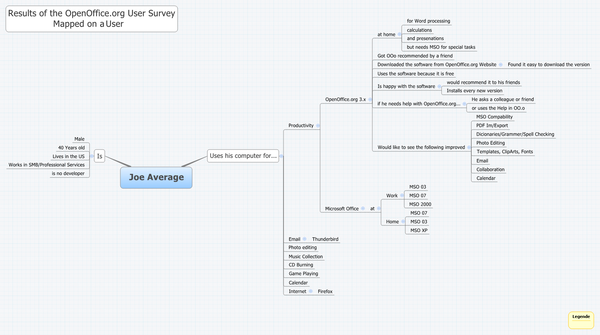Difference between revisions of "Renaissance:Phase 1:OOoUser Survey"
| (19 intermediate revisions by 3 users not shown) | |||
| Line 1: | Line 1: | ||
| − | = OpenOffice.org User Survey = | + | {{User Experience Community}} |
| + | = OpenOffice.org User Survey 2008 = | ||
| + | ==Results== | ||
| + | * OpenOffice.org User Survey 2008 Data from November 1 - February 20, 2009 (Final): <br> | ||
| + | ** [http://wiki.services.openoffice.org/w/images/e/e6/OOoUserSurvey2008_Final.ods Spreadsheet] | ||
| + | * OpenOffice.org User Survey 2008 Data from November 1 - December 18, 2009: <br> | ||
| + | ** [http://wiki.services.openoffice.org/w/images/a/ab/OOoUserSurvey2008.ods Spreadsheet] | ||
| + | ** [http://wiki.services.openoffice.org/w/images/6/62/Results_OpenOffice.org_User_Survey_2008.odp Presentation] | ||
| − | Survey | + | ==Joe Average (User Survey 2008)== |
| − | + | ||
| + | [[Image:Joe Average.png|thumb|600px|left]] | ||
| + | <br clear="all" /> | ||
| + | |||
| + | == Aspects to be considered during data analysis == | ||
| + | |||
| + | 1 Who are our users as revealed by the survey?<br> | ||
| + | 1.1 Do the users represent people we have/had in mind?<br> | ||
| + | 1.2 Are these the users we actually design and develop for?<br> | ||
| + | |||
| + | 2 What value these users most in OOo?<br> | ||
| + | 2.1 Is that something we have expected?<br> | ||
| + | 2.2 Is that something we were hoping for?<br> | ||
| + | 2.3 Is that something we actively worked for?<br> | ||
| + | |||
| + | 3 For what purposes is OOo used?<br> | ||
| + | 3.1 Is that something that we anticipated?<br> | ||
| + | 3.2 Is that something we have worked for?<br> | ||
| + | 3.3 Is that something OOo is really made for?<br> | ||
| + | 3.4 To what extent does that usage cover the functionality of OOo?<br> | ||
| + | |||
| + | 4 What makes OOo so popular among these users?<br> | ||
| + | 4.1 Is that a quality we have expected?<br> | ||
| + | 4.2 Is that a quality we worked/work for?<br> | ||
| + | 4.3 Is that a measurable quality?<br> | ||
| + | |||
| + | 5 How does the distribution of the users look like?<br> | ||
| + | 5.1 Do we have some peaks e.g. in age, usage, language etc.?<br> | ||
| + | |||
| + | 6 To which questions did we hope to collect answers by this survey?<br> | ||
| + | 6.1 Did we get the data we were looking for?<br> | ||
| + | 6.2 Can we get the answers to all our questions from the data?<br> | ||
| + | 6.3 Did this survey meet our own quality criteria in terms of objectivity, reliability and validity?<br> | ||
Latest revision as of 19:20, 25 May 2009
|
|
|---|
|
Quick Navigation
Team |
Contents
OpenOffice.org User Survey 2008
Results
- OpenOffice.org User Survey 2008 Data from November 1 - February 20, 2009 (Final):
- OpenOffice.org User Survey 2008 Data from November 1 - December 18, 2009:
Joe Average (User Survey 2008)
Aspects to be considered during data analysis
1 Who are our users as revealed by the survey?
1.1 Do the users represent people we have/had in mind?
1.2 Are these the users we actually design and develop for?
2 What value these users most in OOo?
2.1 Is that something we have expected?
2.2 Is that something we were hoping for?
2.3 Is that something we actively worked for?
3 For what purposes is OOo used?
3.1 Is that something that we anticipated?
3.2 Is that something we have worked for?
3.3 Is that something OOo is really made for?
3.4 To what extent does that usage cover the functionality of OOo?
4 What makes OOo so popular among these users?
4.1 Is that a quality we have expected?
4.2 Is that a quality we worked/work for?
4.3 Is that a measurable quality?
5 How does the distribution of the users look like?
5.1 Do we have some peaks e.g. in age, usage, language etc.?
6 To which questions did we hope to collect answers by this survey?
6.1 Did we get the data we were looking for?
6.2 Can we get the answers to all our questions from the data?
6.3 Did this survey meet our own quality criteria in terms of objectivity, reliability and validity?

